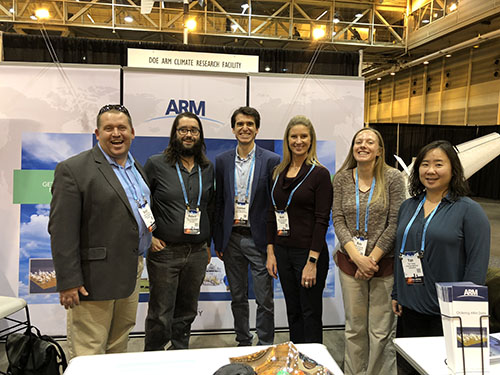ARM’s Scientific Impact Seen at 2017 AGU Fall Meeting
Published: 19 January 2018

If you weren’t able to attend the 2017 American Geophysical Union (AGU) Fall Meeting, you can still discover the research results that were presented featuring ARM Climate Research Facility data.
The 2017 AGU Fall Meeting was held December 11 to 15 in New Orleans, Louisiana. Nearly 22,000 scientists from 92 countries gathered to present. The scientific impact of ARM, a U.S. Department of Energy scientific user facility, can be found in summaries of about 100 workshops, presentations, posters, and more.
Highlights of the meeting included a town hall led by Sally McFarlane, ARM DOE program manager, on interagency coordinated observational activities of the U.S. Global Change Research Program and how they can be improved.
About 40 people attended a town hall on the Large-Eddy Simulation (LES) ARM Symbiotic Simulation and Observation (LASSO) project, gathering recommendations on what ARM should implement for routine operations.
Sessions featured data from ARM field campaigns, including the Midlatitude Continental Convective Clouds Experiment (MC3E), Layered Atlantic Smoke Interactions with Clouds (LASIC), and the ARM West Antarctic Radiation Experiment (AWARE).
Future campaigns were also discussed, including Cloud, Aerosol, and Complex Terrain Interactions (CACTI), which will position cutting-edge atmospheric instruments nearly 3,500 feet above sea level near the rugged Sierras de Córdoba mountain range of north-central Argentina. This area is home to some of the most intense, largest, and longest-lived storms in the world. For part of the campaign, scientists will also deploy the ARM Aerial Facility Gulfstream-159 (G-1) research aircraft to take measurements. With this wealth of instrumentation, CACTI will amass an unprecedented data set about the storms and their interaction with the environment in subtropical South America.
A poster session highlighted ARM efforts using unmanned aerial systems and tethered balloon systems to augment ground measurements at Oliktok Point, Alaska, where the third ARM Mobile Facility (AMF3) is gathering ground data.
More than 40 meeting attendees also volunteered at the ARM exhibit, using the time as “office hours” to talk about their research and connect people to ARM resources.
Preparations are already underway for the 2018 AGU Fall Meeting, which will be held December 10 to 14 in Washington, D.C.
The ARM Climate Research Facility is a DOE Office of Science user facility. The ARM Facility is operated by nine DOE national laboratories.
Keep up with the Atmospheric Observer
Updates on ARM news, events, and opportunities delivered to your inbox
ARM User Profile
ARM welcomes users from all institutions and nations. A free ARM user account is needed to access ARM data.


















